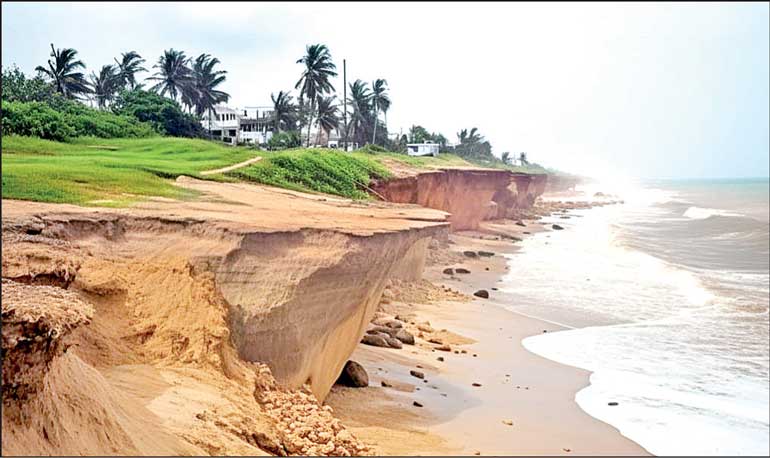Saturday Apr 05, 2025
Saturday Apr 05, 2025
Saturday, 20 May 2023 00:10 - - {{hitsCtrl.values.hits}}

Defining and operationalising a Global Goal on Adaptation could greatly influence the resources and international support available for adaptation measures to developing countries such as Sri Lanka
 The Global Goal on Adaptation (GGA) was established with the Paris Agreement in 2015, where it is outlined under Article 7 as a goal of “enhancing adaptive capacity, strengthening resilience and reducing vulnerability to climate change, with a view to contributing to sustainable development and ensuring an adequate adaptation response in the context of the temperature goal.” However, significant work is needed to translate this outline into an actionable framework and operationalise the process of reporting on and collating the GGA.
The Global Goal on Adaptation (GGA) was established with the Paris Agreement in 2015, where it is outlined under Article 7 as a goal of “enhancing adaptive capacity, strengthening resilience and reducing vulnerability to climate change, with a view to contributing to sustainable development and ensuring an adequate adaptation response in the context of the temperature goal.” However, significant work is needed to translate this outline into an actionable framework and operationalise the process of reporting on and collating the GGA.
To this end, the Parties to the Paris Agreement decided at COP26 in 2021 to explore these questions through the Glasgow-Sharm el-Sheikh work program on the GGA, which runs from 2022-2023 and comprises a total of eight workshops up to COP28. Five of these workshops have taken place so far, with the sixth scheduled to be conducted from 4-5 June in Bonn, Germany. As time is running out toward the end of the work program and COP28, now is an important opportunity to take stock of the state of the conversation: What can the GGA achieve? What are its key elements and considerations? And how will this global goal connect to work on the national and local level?
Designing a global goal
After COP27 in late 2022 and a total of five workshops, a rough shape of the GGA is beginning to materialise. As contained in Decision 3/CMA.4, paragraph 10, there are four dimensions, twelve themes, and eighteen cross-cutting considerations that have been brought forward and frame the discussion right now.
First of all, the four dimensions include assessment, planning, implementation, and monitoring, evaluation, and learning (MEL), which together form the adaptation policy cycle. This means that the GGA should take into consideration not only National Adaptation Plans and other policy documents developed by countries around the world, but all steps of climate change adaptation: understanding current and projected climate change impacts, vulnerabilities, and risks; developing plans and mainstreaming adaptation into national planning processes; implementing these plans on the national and local level; monitoring and evaluating progress based on a set of indicators and targets; and learning from the results to enhance plans and policies in an iterative process. There are important considerations related to these dimensions that could be captured through the GGA, such as support in terms of finance, capacity-building, and technology transfer, or collaboration between different stakeholders and stakeholder groups.
Second, adaptation actions are highly context-specific and will look different depending on a multitude of factors, such as geography, climatic conditions, hazards, demographics, sociocultural factors, and sectors. As identified by Parties and other stakeholders, key thematic areas for adaptation include the following: water; food and agriculture; cities; settlements; infrastructure; health; poverty and livelihoods; terrestrial and freshwater ecosystems; marine and coastal ecosystems; biodiversity; mountain regions; and cultural heritage. This wide variety of adaptation areas, as well as different spatial and temporal scales of adaptation actions, renders it difficult to identify common indicators, metrics, and targets that could be used to establish a global goal.
Finally, there is also a range of cross-cutting considerations that are highly relevant when it comes to adaptation. These include, for example, gender; local, traditional, and Indigenous knowledge systems; human rights; social justice; nature-based solutions; intergenerational equity; intersectional approaches; or using the best available science and science-based indicators. Without covering all relevant perspectives, the GGA would not be complete and unable to address the specific needs of individuals, households, communities, and countries around the globe.
Crucial challenges and needs
Defining a global goal that can capture the world’s progress on climate change adaptation is a highly complex and challenging task. Adaptation is context-specific and can take many forms, from grey infrastructure (e.g., flood protection dykes) to new practices (e.g., climate-smart agriculture) and from nature-based solutions (e.g., planting mangroves) to financial instruments or social protection systems. A global goal needs to consider all the different dimensions, themes, and cross-cutting considerations from a variety of contexts and find a way to compile, collate, or synthesise them into a global target or set of global targets and indicators.
This directly connects to the challenge of measuring progress towards these targets and, therefore, the GGA. In the sixth workshop and beyond, Parties will discuss potential indicators or metrics for adaptation, potentially using a mix of qualitative and quantitative approaches in connection with similar global processes, including the Sustainable Development Goals or the Sendai Framework for Disaster Risk Reduction.
Equity, justice, and inclusiveness are other important considerations. Given the differential impacts of climate change as well as the guiding principle of “common but differentiated responsibilities,” Parties to the Paris Agreement and the United Nations Framework Convention on Climate Change (UNFCCC) need to ensure that the GGA takes into account the needs of vulnerable developing countries, listens to the voices of affected frontline communities, and conducts reporting and assessment processes without posing an additional burden or incurring additional costs for those countries and communities.
A key topic in this regard is adaptation finance, which must be scaled up to enable adaptation at scale and with the speed necessary to protect already affected communities and prevent avoidable losses and damages. The GGA can serve as an instrument to enhance funding by capturing resource and technology needs to channel funding towards them and help to strengthen local and national adaptation efforts. It also provides an opportunity to incentivise and mobilise private sector involvement and build multi-actor partnerships for adaptation, risk management, and resilience-building across all levels.
Designing the GGA is further complicated by the fact that it cannot be seen as a completely independent process but is rather deeply interconnected with other workstreams and negotiation agenda items under the UNFCCC. This includes, for example, the Global Stocktake (GST), which is the collective global assessment of progress towards achieving the goals of the Paris Agreement. The first GST is also being discussed at the moment and should incorporate the GGA under its adaptation component, with both the GST and the GGA work programme scheduled to end this year.
Utilising a global goal to enhance local and national action
The GGA could play a vital role for national and local climate action by providing a shared vision and framework for adaptation. It signifies an international commitment to support and prioritise adaptation efforts and could galvanise national governments to integrate climate adaptation into their development strategies and policies. By doing so, it encourages a proactive and anticipatory approach to managing climate risks and could even unlock opportunities to benefit from sectoral shifts and a just transition towards green, resilient, and climate-smart economies.
Particularly for a climate-vulnerable developing country like Sri Lanka, climate change is a topic of paramount importance. Defining and operationalising the GGA and its mechanisms for support could greatly influence the resources and international support available to Sri Lanka for its adaptation efforts, as well as provide guidance to align national processes within a global framework and common metrics and methodologies. This could potentially include adaptation funding, technical support for adaptation measures, and capacity-building and knowledge transfer for both immediate and longer-term adaptation measures.
(The writer works as Director: Research and Knowledge Management at SLYCAN Trust, a non-profit think tank based in Sri Lanka. His work focuses on climate change, adaptation, resilience, ecosystem conservation, just transition, human mobility, and a range of related issues. He holds a Master’s degree in Education from the University of Cologne, Germany and is a regular writer to several international and local media outlets.)
Discover Kapruka, the leading online shopping platform in Sri Lanka, where you can conveniently send Gifts and Flowers to your loved ones for any event including Valentine ’s Day. Explore a wide range of popular Shopping Categories on Kapruka, including Toys, Groceries, Electronics, Birthday Cakes, Fruits, Chocolates, Flower Bouquets, Clothing, Watches, Lingerie, Gift Sets and Jewellery. Also if you’re interested in selling with Kapruka, Partner Central by Kapruka is the best solution to start with. Moreover, through Kapruka Global Shop, you can also enjoy the convenience of purchasing products from renowned platforms like Amazon and eBay and have them delivered to Sri Lanka.
Discover Kapruka, the leading online shopping platform in Sri Lanka, where you can conveniently send Gifts and Flowers to your loved ones for any event including Valentine ’s Day. Explore a wide range of popular Shopping Categories on Kapruka, including Toys, Groceries, Electronics, Birthday Cakes, Fruits, Chocolates, Flower Bouquets, Clothing, Watches, Lingerie, Gift Sets and Jewellery. Also if you’re interested in selling with Kapruka, Partner Central by Kapruka is the best solution to start with. Moreover, through Kapruka Global Shop, you can also enjoy the convenience of purchasing products from renowned platforms like Amazon and eBay and have them delivered to Sri Lanka.